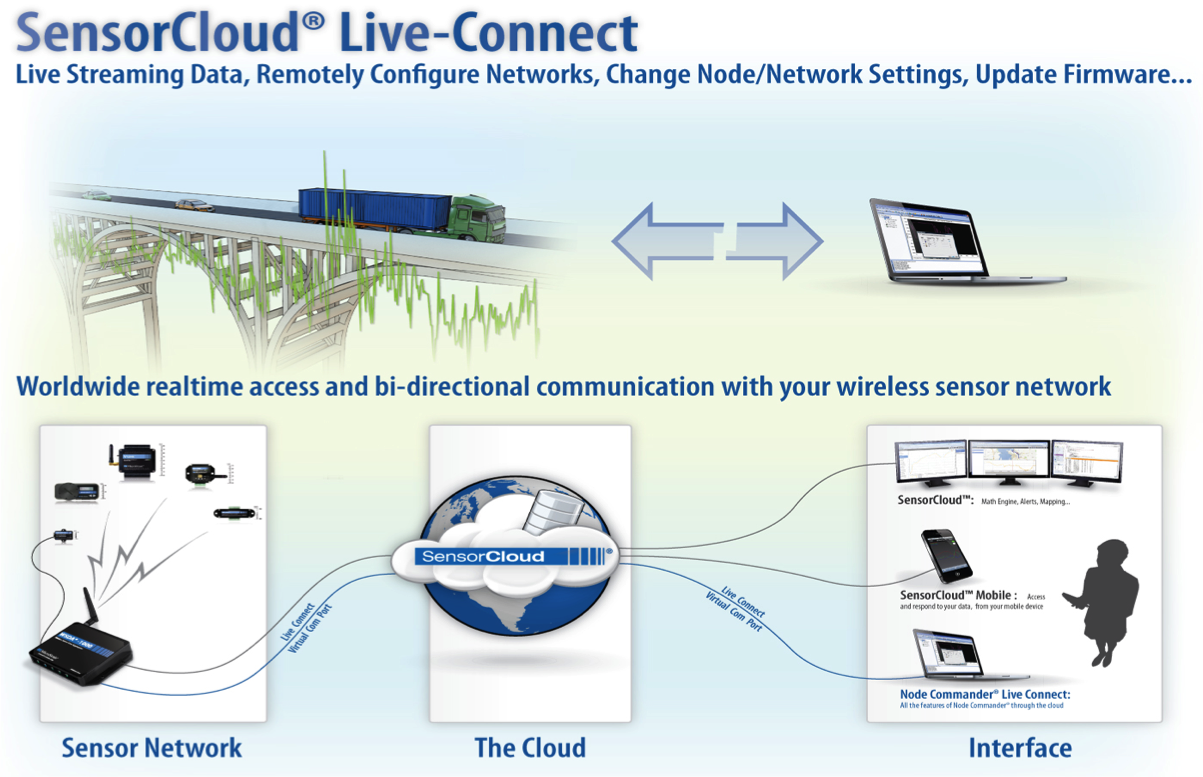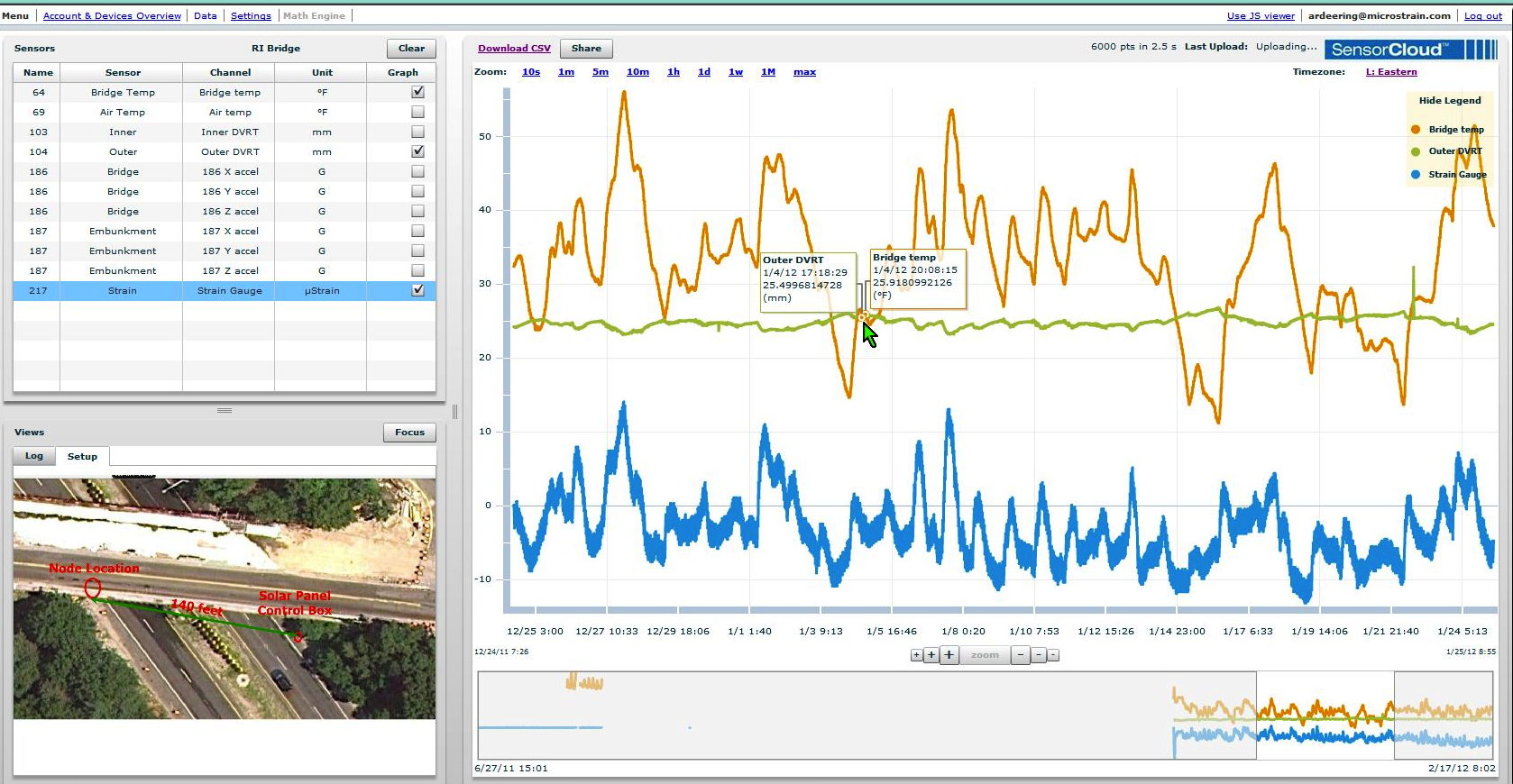Applications
Downloads
Tags
Parameters
Related Products
- By
- Posted Monday, July 27, 2015 - 11:45
MicroStrain wireless bridge monitoring systems enable long-term performance diagnostics with energy harvesting and remote cloud-based data analytics.
 MicroStrain’s wireless structural monitoring system is a new network tool for enhanced long-term performance diagnostics and prognostics. Network capabilities include an autonomous, energy independent sensor platform for streamlined installation and reduced battery maintenance. Wireless capabilities eliminate the cost and installation burden of cabling. As a result, sensors can be quickly deployed in discrete locations with less disruption on traffic and concurrent construction. Additionally, a cloud-based management and modeling tool supports any MicroStrain wireless or third party health and usage data. Current commercial applications include bridges, aircraft and manufacturing processes.
MicroStrain’s wireless structural monitoring system is a new network tool for enhanced long-term performance diagnostics and prognostics. Network capabilities include an autonomous, energy independent sensor platform for streamlined installation and reduced battery maintenance. Wireless capabilities eliminate the cost and installation burden of cabling. As a result, sensors can be quickly deployed in discrete locations with less disruption on traffic and concurrent construction. Additionally, a cloud-based management and modeling tool supports any MicroStrain wireless or third party health and usage data. Current commercial applications include bridges, aircraft and manufacturing processes.
A diverse portfolio of miniature sensor nodes provides measurement capabilities for performance parameters such as vibration, load, strain, displacement, temperature, corrosion and tilt/inclination. New techniques for integrating advanced sensing capabilities into structural and load bearing design elements enable embedded monitoring intelligence to be permanently architected into the structure. In addition, low-power, synchronized data communication protocols facilitate wireless transmission that can support thousands of nodes on a single base station, without compromising reliability.
Wireless Monitoring
Repeated traffic loading imparts significant strain on bridge structures. Servicing infrastructure, quantifying usage, and predicting failure requires monitoring numerous positions and parameters. Wired sensors are subject to scale and environment limitations that prevent broader deployment. Furthermore, hardwired solutions are difficult and disruptive to install, expensive to maintain, and do not readily transfer between bridge designs.
Wireless sensor networks can be deployed with greater scale and cost-efficiency on remote, high value equipment. MicroStrain has developed integrated wireless monitoring solutions for many structural applications. These include civil bridge projects[i] and defense aircraft applications[ii], and they provide significant innovation in these areas. Advanced data synchronization capabilities ensure wireless aggregation of sensor information using time as a unifying variable. Ultra-low power FRAM memory and event driven triggers on each node allows the network to capture key health and usage information with less energy. Additionally, scalable system characteristics support the distribution of many sensors in a single network. Networks support landline, cellular or satellite communication. Virtually any sensor can be used with the MicroStrain network. As a result, operators can tailor monitoring to provide their necessary channels.
Rapid Installation
Bridge operators cannot afford to disrupt or complicate normal bridge operation with cumbersome monitoring systems and installation practices. Disruptions to concurrent construction activities or traffic flow undermine the cost and convenience of enhanced sensing capabilities. MicroStrain miniature sensors rapidly install on existing bridges and integrate with future bridge designs.
Wireless nodes enable discrete placement without labor intensive and damage prone wire trails. The network supports detailed inspection, periodic evaluation, and long-term monitoring. Additionally, for new construction, Wireless Integrated Shear Pins (WISP), first designed to monitor loads, fatigue, and damage on aircraft landing gear, provide fully calibrated, environmentally sealed integrated performance monitoring capabilities. MicroStrain’s miniature wireless nodes are also capable of synchronized data acquisition from accelerometers, geophones, bonded or welded strain gauges, LVDTs, thermocouples, and corrosion sensors. Automated bridge monitoring from remote sites is supported by our wireless sensor data aggregators (WSDAs), which collect data from the scalable sensor network using time as a unifying variable.
Energy Independent
Remote assets are highly limited in their access to conventional sources of energy. In temporary monitoring application of a short duration, MicroStrain’s ultra-low power microelectronics can be sufficient to provide autonomous operation. The monitoring system offers efficiently scheduled data transmission protocols as well as an event driven sleep mode to maintain requisite data with minimal power. However, permanent solutions are necessary to extract meaningful life-cycle performance metrics. Eliminating battery maintenance through the application of renewable, harvested energy can provide long-term power for self-sufficient wireless monitoring solutions.
Solar energy is a logical choice for many regions of America’s highway infrastructure. Solar energy harvesting devices can decouple sensor nodes from the limitations of traditional power supplies. MicroStrain’s experience includes developing solar, strain, vibration and thermal powered sensor networks. The deployment of a self-powered miniature sensor can significantly enhance data extraction capabilities while simultaneously reducing the need for visual inspections and battery maintenance.
Secure, Cloud-Based Data
 Continuous health and usage monitoring generates massive datasets. This data is necessary for optimizing operation and maintenance, but it can also create data visualization and management challenges. MicroStrain’s SensorCloud™ offers a secure, cloud-based sensor data management platform with virtually unlimited storage, rapid visualization capabilities, and user-defined alert channels. SensorCloud™ makes big data highly accessible and allows engineers to drill down on individual data points in seconds.
Continuous health and usage monitoring generates massive datasets. This data is necessary for optimizing operation and maintenance, but it can also create data visualization and management challenges. MicroStrain’s SensorCloud™ offers a secure, cloud-based sensor data management platform with virtually unlimited storage, rapid visualization capabilities, and user-defined alert channels. SensorCloud™ makes big data highly accessible and allows engineers to drill down on individual data points in seconds.
SensorCloud™ is equipped with on-board analytical and modeling tools to allow users to develop, verify, and validate new algorithms. Furthermore, the open API platform supports importation of analytical metrics and additional data types (such as annotative notes and images.) By these means, usage patterns such as number of crossings, average daily load traffic, resonant frequency, and cumulative fatigue can be leveraged over the long-term for more effective resource prioritization.
Live Connect
Accessibility is integral to maintaining an effective remote monitoring network. Through its cloud-based data exchange platform, MicroStrain’s wireless network supports live remote access and control. Long-term data are pushed to the cloud using cellular network, as well as being locally archived within the wireless data aggregator. As a result, users can configure, manage and maintain distributed monitoring systems more efficiently and at a lower cost.
MicroStrain’s Live Connect also enables bridge operators to remotely monitor live bridge performance during controlled testing events. Leveraging strain events, such as the defined crossing of traffic loads, the performance of specific locations can be remotely observed in real time.
Bridge Monitoring Experience
MicroStrain has supported numerous major wireless installations that actively monitor the structural strains and seismic activities of major bridge spans.[iii],[iv] One example is the Ben Franklin Bridge that spans the Delaware River from Philadelphia, PA to Camden, NJ.[v] The wireless monitoring system was accessed remotely over a cellular telephone link. The wireless nodes measured structural strains in the cantilever beams as passenger trains transverse the span. Measurements were taken over several months to quantify bridge fatigue. Performance monitoring validated that the bridge was operating within its designed range, and allowed operators to avoid a costly overhaul.
MicroStrain has also deployed self-powered wireless bridge monitoring system for state, federal, and foreign bridge programs. Examples of these include the Great Road State Bridge in North Smithfield, RI, the Goldstar Bridge spanning the Thames River in New Haven, CT, and the Corinth Canal Bridge in Corinth, Greece. Each site integrates miniature solar energy harvesters to power a network consisting of MicroStrain’s wireless sensor data aggregator and wireless nodes. In Corinth, a seismically active region, the bridge design featured partial seismic isolation, and the bridge operator wanted to assess the effectiveness of the isolation design during actual seismic events. The system samples accelerations continuously at 200 Hz. A circular memory buffer with event triggers automatically retrieves and saves pre- and post-event data when user-defined thresholds are met.
Application of MicroStrain’s cloud-based data exchange has enabled bridge operators and collaborative research programs to autonomously aggregate, visualize, and analyze high-resolution health and usage data. Data collection requirements often exceed 1GB/day for a 100Hz, 10-node network. Larger spans can require hundreds, if not thousands of embedded sensors. Over time, maintaining and collaborating on bridge performance data can present a substantial burden. SensorCloud™ has enabled bridge researcher engineers to cost effectively maintain, share and model bridge performance on virtually any scale.
The coupling of advanced wireless sensor networks with innovative cloud-based data analytics revolutionizes performance monitoring of remote structures. Used over the long-term, operators can gain valuable insight into the deterioration of structures and its corresponding effect on performance. By making bridge monitoring systems less disruptive to install and easier to manage, these benefits can be achieved more efficiently, and on a greater scale. As a result, both existing and next generation infrastructure can access the values of condition based maintenance, repair and modeling.
[i]Arms, S. W. et al., “Remotely Reprogrammable Sensors for Structural Health Monitoring,” Structural Materials Technology (SMT):NDE/NDT for Highways and Bridges, Sept 16, 2004, Buffalo, NY
[ii]Arms, S.W. et al., “Flight Testing of Wireless Sensing Networks for Rotorcraft Structural Health and Usage Management Systems”, accepted for presentation at AIAC14, 28 Feb – 3 Mar 2011, Melbourne, Australia
[iii]Townsend C.P., Hamel, M.J., Arms, S.W.; “Scaleable Wireless Web Enabled Sensor Networks”, proc. SPIE's
9th Int'l Symposium on Smart Structures & Materials and 7th Int'l Symposium on Nondestructive Evaluation and Health Monitoring of Aging Infrastructure, San Diego, CA, paper presented 17-21 March, 2002
[iv] Galbreath J.H., Townsend, C.P., Mundell, S.W., Arms, S.W; “Civil Structure Strain Monitoring with Power-Efficient High-Speed Wireless Sensor Networks”, International Workshop for Structural Health Monitoring, by invitation, Stanford, CA, September 2003
[v]Rong, A.Y. & Cuffari, M.A.; “Structural Health Monitoring of a Steel Bridge Using Wireless Strain Gauges” Structural Materials Technology VI, pages 327-330, NDE/NDT for Highways & Bridges, Buffalo, NY, 16 Sep 2004










